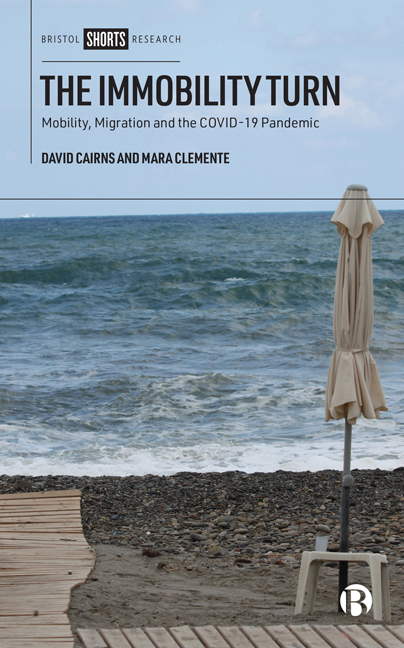Book contents
- Frontmatter
- Contents
- List of Figures
- About the Authors
- one COVID-19 and the Immobility Turn
- two Theorizing the Immobility Turn
- three From Overtourism to Undertourism, and Back Again
- four International Student Mobility and Immobility
- five Maintaining Migration during a Pandemic
- six Mobility after an Immobility Turn
- Notes
- References
- Index
one - COVID-19 and the Immobility Turn
Published online by Cambridge University Press: 18 January 2024
- Frontmatter
- Contents
- List of Figures
- About the Authors
- one COVID-19 and the Immobility Turn
- two Theorizing the Immobility Turn
- three From Overtourism to Undertourism, and Back Again
- four International Student Mobility and Immobility
- five Maintaining Migration during a Pandemic
- six Mobility after an Immobility Turn
- Notes
- References
- Index
Summary
The Immobility Turn is about transformations that have taken place in geographical mobility since the start of the COVID-19 pandemic, with long periods of restricted access to international and interregional circulation constituting a loss of the previously taken-for-granted freedom to travel. This extends to creating difficulties for industries that had grown reliant on free circulation of people – most prominently, tourism, universities and businesses employing large numbers of migrant labourers. Such is the scale of these transformations that there may have been a change in the pivotal position occupied by mobility in many societies, leading us to hypothesize that an ‘immobility turn’ has taken place. This follows on from the preceding ‘mobility turn’, which can be seen as a way of theorizing the multiplication of mobility in social, economic and political life, taking advantage of expanded levels of global interconnectedness.
Although the transformation in the fortunes of mobility is strongly associated with the pandemic, international travel had already attracted suspicion for other reasons, most notably the negative impact on the environment from aviation and the difficulty of hosting large numbers of incoming tourists in popular destinations. It might then be argued that the immobility turn is also a product of pre-pandemic issues, some of which we discuss in this book. Nevertheless, it was the rapid shutdown of societies and the curtailment of international travel in early 2020 that made many people aware of the fragility of free movement, creating the need to adopt more insular lifestyles. And while the turn towards immobility is not seen as a permanent change – although it may have felt so at times during the early months of the pandemic – the after-effects are likely to be long-lasting, creating an impetus for rethinking and re-examining some of the assumptions that informed the expansion of geographical mobility in the pre-pandemic years.
In this introductory chapter, we provide a brief outline of this position and an overview of what is to come in the book, starting with a look back at what was described as ‘the mobility turn.’ This was accompanied by the emergence of a ‘new mobilities paradigm’ that aimed to capture the sense of boundlessness that followed the multiplication of mobility at the end of the 20th century and beginning of the 21st century. The intention in the discussion that follows is to look at some key aspects of this expansion, taking into account not only rising levels of human circulation but also the diversification and apparent democratization of international travel, popularized to the point that regularly spending time abroad became a commonplace experience.
- Type
- Chapter
- Information
- The Immobility TurnMobility, Migration and the COVID-19 Pandemic, pp. 1 - 20Publisher: Bristol University PressPrint publication year: 2023

